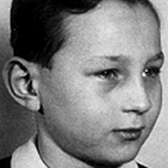
-
Learn More about George
György was born March 28, 1934 in Budapest, Hungary. He was the only child of middle class Jewish parents. György’s father, Istvan, was an engineer responsible for producing hydraulic grape presses for wineries. His mother, Margit, worked as a legal secretary. The Pick family could trace its history in the Austro-Hungarian Empire back to the early 1700s, and György had many close relatives in the city.
In the 1930s, Hungary’s authoritarian government pushed the country into close alignment with Nazi Germany. Hitler’s speeches were broadcast on the radio and, even though György could not understand German, he was disturbed by the anger he heard in the dictator’s voice. Hungary’s anti-Jewish laws were passed between 1938 and 1941. Modeled after Germany’s Nuremberg Laws, they defined Jews in racial terms, excluded Jews from various professions, and severely restricted their participation in economic life. As a result, György's father lost his job. Margit was able to continue working as a legal secretary in the law firm of her uncle, Dr. Pal Kornhauser.
In 1940, Hungary officially allied itself with the Axis powers. György’s father was conscripted into a labor battalion and sent to the newly annexed territory of Subcarpathian Rus (part of interwar Czechoslovakia and present-day Ukraine), where he was forced to build roads for the military. He was released after three months, but was again conscripted in 1943 and 1944. György attended school until March 1944, when German troops occupied Hungary.
In mid-May 1944, the Hungarian authorities, in coordination with the German Security Police, began to systematically deport the Hungarian Jews. In less than two months, nearly 440,000 Jews were deported from Hungary. Most were deported to the Auschwitz-Birkenau killing center, but thousands were also sent to the border with Austria to be deployed at digging fortification trenches. By the end of July 1944, the only Jewish community left in Hungary was that of Budapest, the capital.
In June, the Picks, along with other Jews in the capital, had to move into special buildings marked with yellow stars, and all of their belongings were confiscated. That October, the Hungarian fascists, known as the Arrow Cross Party, took power, and began to target the remaining Jews, sending some on forced marches towards concentration camps and executing others. György’s family hid in a vacant building disguised as a uniform factory. A month later, they, along with the 160 to 170 Jews hiding there were discovered. At the age of ten, György was placed in a Swiss Red Cross protected orphanage with 500 other children, but he soon escaped and returned to his family. After the war, György learned that the children who had remained in the orphanage were killed. Two weeks after this incident, the Picks were sent to the Budapest ghetto. György’s family lived in a building with no water or electricity that also housed a number of elderly people from a senior care home. During air raids everyone living in the building would go to the basement for shelter. György and his family remained there during the final siege of the city.
In January, 1945, the ghetto was liberated by Soviet troops. Approximately 130 of György’s relatives had been killed at Auschwitz-Birkenau, including Margit’s uncle, Dr. Pal Kornhauser. After the war, György remained in Hungary, where he earned a degree in engineering. In 1956, he participated in the Hungarian Revolution against the Soviet-backed Communist government. Once the Soviets crushed the revolution, he fled the country and came to the United States as a political refugee. He earned his Ph.D. in 1965, and then worked for the United States Navy as an aerospace engineer until his retirement in 1995. He and his wife, Leticia Flores Pick, live in Arlington, Virginia.
Why I Volunteer
I regard my volunteering in the US Holocaust Memorial Museum as an important mission. Being a survivor I represent a direct witness and link to the Holocaust for those who visit the Museum. Over the past 29 years I have encountered many people whose visits became more meaningful after they found out that I was a survivor. That fact made the Museum experience for them more real. I enjoy meeting, teaching, and helping people better understand why it is important to visit our institution.


















